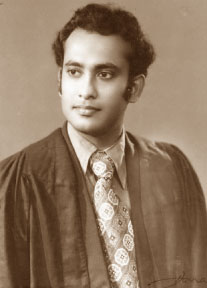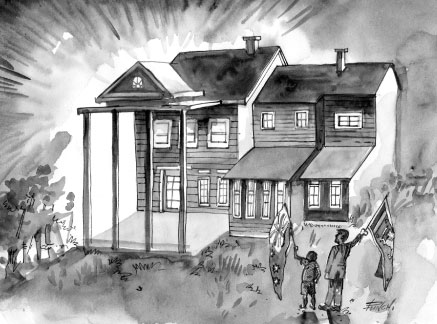Sunil Govinnage's fictional world and cultural otherness
By Prof. Wimal DISSANAYAKE
The protagonists of Sunil Govinnage's stories encode the anxieties
and desires of the diasporics, caught as they are between the two
chimeras of home and exile. The dialectic between localism and globalism
only serves to intensify the pains of this phenomenon.
 |
|
Sunil Govinnage |
The notions of cultural Otherness and difference, which are vitally
connected to cultural identity, run like an underground stream
throughout these stories. One has only to glance at the contemporary
Australian political landscape to realize the salience of Otherness and
difference. The bellicose rhetoric coming out of Pauline Hanson and the
One Nation Party has struck a deep chord of resonance in nearly a
quarter of the Australian population as reflected in the recent
Queensland election, while campaigns, like, 'Living in Harmony',
promoting slogans like 'You, Me, Australian' are seeking to counteract
this pernicious trend. Many of Sunil Govinnage's short stories need to
be understood against this background. In fact, in one of the stories,
there are clear references to the One Nation Party. The idea of cultural
Otherness, therefore, carries a heavy freight of social meaning in
Govinnage's stories.
Roland Barthes once remarked that when the bourgeois individual is
confronted by the Other, he 'blinds himself, ignores and denies him (the
Other), or else transforms him into himself.' How the dominant class
seeks to contain the Other is most revealing. It caricatures the Other,
silences and marginalizes the Other, and turns the Other into a comic
spectacle. All these are, needless to say, strategies of negation.
Hence, the compelling need to invest the Other with a complex human
agency and construct alternative discursive horizons within which the
Other could be purposefully situated. Sunil Govinnage has understood, as
revealed in his stories, the importance of this move. He is constantly
seeking to constrict more complex images of the Other through two
imbricated registers of articulation: narrativity and reflexivity. In
his stories, Govinnage is aiming to put into circulation more
multi-faceted self-images of the immigrants in Australia and their
social imaginary.
What is interesting to note about Sunil Govinnage's stories is his
desire to institute a more complex dialectic regarding black
Australians. There is a widespread tendency to lump all black
Australians together without taking into consideration the cultural
differences among, say, Indians, Pakistanis, Bangladeshis and Sri
Lankans. In his stories, Govinnage has sought to point out the
importance of recognizing differences among black Australians as a way
of acquiring a more complex and nuanced understanding of black
Australians. Secondly, he has endeavored to institute another dialectic,
namely, that between collective and personal identity. It is indeed true
that Sri Lankan-born Australians share a set of common cultural traits
and behavioral patterns. But, at the same time, as a writer, he is also
interested in charting the relationship between personal identity and
collective identity. In many of the stories collected in this volume
this facet of cultural Otherness receives attention.
As one begins to roam in Govinnage's fictional world, one begins to
realize how important the ideas of hybridity and border-crossing are to
the density of that world. The protagonists cross national,
geographical, cultural and linguistic boundaries with no perfect
destination in sight. In-betweenness is the primary condition of their
life. The protagonists are Sri Lankans who have chosen to settle down in
Australia. But the pull of the past, the attachments to the culture left
behind, exert a strong influence in their day-to-day life. They like the
modern material comforts-cars, home appliances etc-as well as the
respite from the ethnic conflict that has engulfed their native land. At
the same time, they cannot totally turn their backs on the past. In one
of the stories, while the rest of the family has opted for Australian
passports, the protagonist tenaciously holds on to his Sri Lankan
passport. The bilinguality and biculturality that traverse the narrative
discourse points to this in-betweenness and the tensions it generates.
There is a sense of irritability that characterizes many of the
protagonists which admirably suggests the predicament of the immigrant.
In these stories, we find an interesting interplay between home and
exile. Both terms are constantly being inverted. At times, the home is
full of peril and exile offers sanctuary, and at other times the exact
reverse seems to be the case.
How an emigrant becomes an immigrant and attains full cultural
membership is a question of great significance that seems to engage the
imagination of the author very deeply. The shadow of his past and
cultural heritage inexorably falls across his new Australian life. The
narrator occupies an interstitial space from which he could explore both
roots and routes. Unable and unwilling to occupy a single territory, the
protagonists shuttle back and forth through social imaginaries in search
of contentment that always seem to elude them. The idea of hybridity,
therefore, becomes very important to the meanings and meta-meanings of
these stories. In bringing the concept of hybridity to life on the page,
Sunil Govinnage underlines the necessary self-understanding of writers
as both reflectors and shapers of social reality. The concept of
hybridity, though not without its share of problems, has proved to be a
useful analytical construct as proved by thinkers as diverse as Bakhtin
and Homi Bhabha. Homi Bhabha has remarked that hybridity can be
interpreted as unexplored moments of the history of modernity. The
experiences that Govinnage is recounting are products of modernity and
post-modernity and hence it is only natural that he should focus on the
idea of hybridity.
 Along
with the topics of cultural identity, Otherness, localism and globalism
and hybridity, the author of these stories has fore grounded the idea of
Australianness. Australia, despite the predilections of many, is not a
unified and integrated entity, but represents a coming together and
negotiations of multiplicities. It is not a monolith, nor is it an
immutable and permanent entity. It is, rather, a discursive
construction, a representational space, in which an incessant
contestation of meaning is taking place. It is a land of the Aborigines;
it is a settler society; it is a post-colonial society; it is a
multi-cultural society which is inhabited by people of European and
Asian descent. Given these facts, Australia has always to be understood
by its multi-layerdness. Therefore, the unified meta-narrative of
Australian nationhood that is being propagated has to be challenged from
different vantage points. In many of the stories contained in this
collection, this is precisely what the author is seeking to do. How a
nation tells its unifying and legitimizing story to its citizens is
exceedingly important in the understanding of nationhood, and writers
like Govinnage who see literature as a vital adjunct of the public
sphere in the Habermasian sense are desirous of presenting alternate
perspectives and submerged voices to challenge the official efforts. In
Govinnage's stories there is an inverted sense of attachment and
detachment. He moves towards a cultural world in order to extricate
himself from that world, and he moves away from it in order to get close
to it. He has an ability to see extraordinariness in ordinariness,
thereby undercutting the deceptively simple structures of his stories.
His sharp eye for the shape and feel of little things serves to direct
our attention to the larger issues concealed in the ostensibly simple
events. Govinnage narrates his world with controlled emotion and
narrative economy, rather than taking the easy route of
oversimplification and excessive self-display-routes that almost always
lead to artistic diminution. In many of the stories, Sunil Govinnage
works at the interface of cultures, struggling to explore emotions he
cannot quite name and his narrative economy aid in this effort. His
desire to untangle some important strands in the knotted fabric that is
Australian culture is well served by his artistic choices and
representational strategies. Along
with the topics of cultural identity, Otherness, localism and globalism
and hybridity, the author of these stories has fore grounded the idea of
Australianness. Australia, despite the predilections of many, is not a
unified and integrated entity, but represents a coming together and
negotiations of multiplicities. It is not a monolith, nor is it an
immutable and permanent entity. It is, rather, a discursive
construction, a representational space, in which an incessant
contestation of meaning is taking place. It is a land of the Aborigines;
it is a settler society; it is a post-colonial society; it is a
multi-cultural society which is inhabited by people of European and
Asian descent. Given these facts, Australia has always to be understood
by its multi-layerdness. Therefore, the unified meta-narrative of
Australian nationhood that is being propagated has to be challenged from
different vantage points. In many of the stories contained in this
collection, this is precisely what the author is seeking to do. How a
nation tells its unifying and legitimizing story to its citizens is
exceedingly important in the understanding of nationhood, and writers
like Govinnage who see literature as a vital adjunct of the public
sphere in the Habermasian sense are desirous of presenting alternate
perspectives and submerged voices to challenge the official efforts. In
Govinnage's stories there is an inverted sense of attachment and
detachment. He moves towards a cultural world in order to extricate
himself from that world, and he moves away from it in order to get close
to it. He has an ability to see extraordinariness in ordinariness,
thereby undercutting the deceptively simple structures of his stories.
His sharp eye for the shape and feel of little things serves to direct
our attention to the larger issues concealed in the ostensibly simple
events. Govinnage narrates his world with controlled emotion and
narrative economy, rather than taking the easy route of
oversimplification and excessive self-display-routes that almost always
lead to artistic diminution. In many of the stories, Sunil Govinnage
works at the interface of cultures, struggling to explore emotions he
cannot quite name and his narrative economy aid in this effort. His
desire to untangle some important strands in the knotted fabric that is
Australian culture is well served by his artistic choices and
representational strategies.
In Sunil Govinnage's case, he writes, for the most part, in standard
English. His is a clear and uncomplicated prose without any ostentatious
desires to dress it up in ornate finery. However, he has tried to
combine standard English with Australian and Sri Lankan English to
encode the complexities of diasporic existence in Australia. The
dialogue between the husband and wife or the statements made by the
father addressing his children are somewhat stilted, thereby capturing
the dynamics of Sinhalese sensibility as it inflects Sri Lankan English.
Despite the worries, fears and frustrations that the characters in
these stories have to contend with, one recognizes the writer's desire
to experience the joy of life, and even more importantly, to experience
the joy of recording that joy.
(Professor Wimal Dissanayake teaches at University of Hawaii, USA.
This write up is an edited version from Professor Dissanayake's
Introduction to Sunil Govinnage's short story collection, Black Swans
and Other Stories and published with permission of the author)
|

